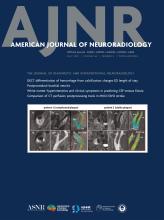This article requires a subscription to view the full text. If you have a subscription you may use the login form below to view the article. Access to this article can also be purchased.
Graphical Abstract
Abstract
BACKGROUND AND PURPOSE: Complicated American Heart Association (AHA) lesion type VI plaques and cCAPs, characterized by the presence of intraplaque hemorrhage and a surface defect or thrombus, are strongly associated with ischemic stroke and stroke recurrence. Hemodynamics seem to play a relevant role in their development. Thus, we investigated the association of 4D-flow MRI-derived local wall shear stress (WSS) and the oscillatory shear index (OSI) with the presence of cCAPs in patients with mild-to-moderate ICA stenosis.
MATERIALS AND METHODS: From a prospective and consecutive cross-sectional study with 121 patients with high cardiovascular risk, 39 patients (49 carotid arteries) demonstrated a 10%–50% ICA stenosis and were included in this analysis. Plaque composition was determined according to the modified AHA classification of lesions by high-resolution multicontrast 3T MRI. We determined WSS (minimum, mean, and maximum) and the OSI in vivo by 4D-flow MRI at different locations within the stenosis (upstream, stenosis center, and downstream). We studied the association of each hemodynamic parameter with the presence cCAPs by logistic regression analysis adjusted for age, sex and plaque thickness.
RESULTS: Eleven (22.4%) of the 49 cases of ICA stenosis in our cohort showed cCAP. WSS and OSI at the beginning of the stenosis did not differ between complicated and stable plaques. By contrast, WSS was significantly higher in the stenosis center and poststenotic region in cCAPs. OSI was significantly higher in the stenosis center of stable plaques. Logistic regression analysis revealed a significant association for WSSmean (OR per SD increase, 1.97; 95% CI, 1.14–3.39, P = .015) and for WSSmaximum (OR per SD increase, 1.84; 95% CI, 1.10–3.08, P = .020), but not for WSSminimum and OSI with the presence of cCAPs.
CONCLUSIONS: Higher WSS in ICA stenosis was significantly associated with the presence of cCAPs, underlining the potential role of hemodynamics in their development.
ABBREVIATIONS:
- AHA
- American Heart Association
- BW
- bandwidth
- cCAP
- complicated carotid artery plaque
- CFD
- computational fluid dynamics
- OSI
- oscillatory shear index
- TA
- acquisition time
- WSS
- wall shear stress
- © 2025 by American Journal of Neuroradiology













